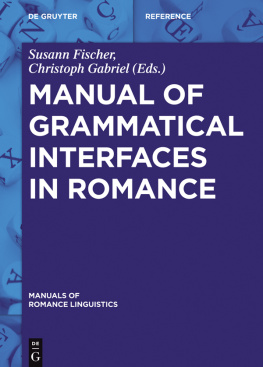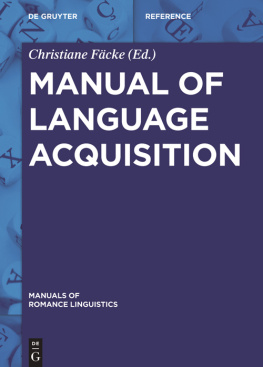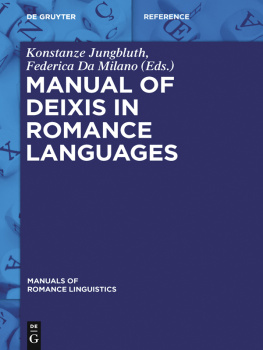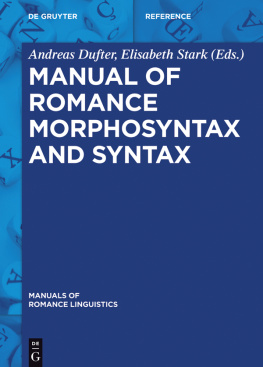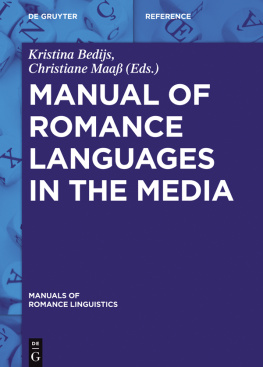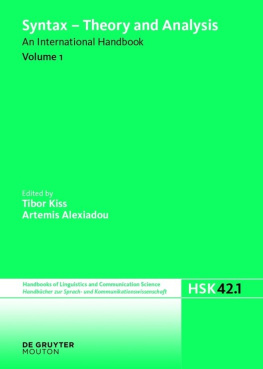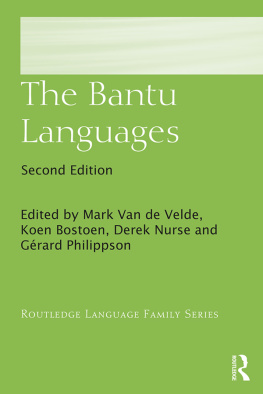Guide

Manual of Grammatical Interfaces in Romance
MRL 10
Manuals of
Romance Linguistics
Manuels de linguistique romane
Manuali di linguistica romanza
Manuales de lingstica romnica
Edited by
Gnter Holtus and Fernando Snchez Miret
Volume 10

ISBN 978-3-11-031178-5
e-ISBN (PDF) 978-3-11-031186-0
e-ISBN (EPUB) 978-3-11-039483-2
Library of Congress Cataloging-in-Publication Data
A CIP catalog record for this book has been applied for at the Library of Congress.
Bibliographic information published by the Deutsche Nationalbibliothek
The Deutsche Nationalbibliothek lists this publication in the Deutsche Nationalbibliografie; detailed bibliographic data are available on the Internet at http://dnb.dnb.de.
2016 Walter de Gruyter GmbH, Berlin/Boston
Cover image: Marco2811/fotolia
Typesetting: RoyalStandard, Hong Kong
www.degruyter.com
Manuals of Romance Linguistics
The new international handbook series Manuals of Romance Linguistics ( MRL ) will offer an extensive, systematic and state-of-the-art overview of linguistic research in the entire field of present-day Romance Studies.
MRL aims to update and expand the contents of the two major reference works available to date: Lexikon der Romanistischen Linguistik ( LRL ) (19882005, vol. 18) and Romanische Sprachgeschichte ( RSG ) (20032008, vol. 13). It will also seek to integrate new research trends as well as topics that have not yet been explored systematically.
Given that a complete revision of LRL and RSG would not be feasible, at least not in a sensible timeframe, the MRL editors have opted for a modular approach that is much more flexible:
The series will include approximately 60 volumes (each comprised of approx. 400600 pages and 1530 chapters). Each volume will focus on the most central aspects of its topic in a clear and structured manner. As a series, the volumes will cover the entire field of present-day Romance Linguistics, but they can also be used individually. Given that the work on individual MRL volumes will be nowhere near as time-consuming as that on a major reference work in the style of LRL , it will be much easier to take into account even the most recent trends and developments in linguistic research.
MRL s languages of publication are French, Spanish, Italian, English and, in exceptional cases, Portuguese. Each volume will consistently be written in only one of these languages. In each case, the choice of language will depend on the specific topic. English will be used for topics that are of more general relevance beyond the field of Romance Studies (for example Manual of Language Acquisition or Manual of Romance Languages in the Media ).
The focus of each volume will be either (1) on one specific language or (2) on one specific research field. Concerning volumes of the first type, each of the Romance languages including Romance-based creoles will be discussed in a separate volume. A particularly strong focus will be placed on the smaller languages ( linguae minores ) that other reference works have not treated extensively. MRL will comprise volumes on Friulian, Corsican, Galician, Vulgar Latin, among others, as well as a Manual of Judaeo-Romance Linguistics and Philology .Volumes of the second type will be devoted to the systematic presentation of all traditional and new fields of Romance Linguistics, with the research methods of Romance Linguistics being discussed in a separate volume. Dynamic new research fields and trends will yet again be of particular interest, because although they have become increasingly important in both research and teaching, older reference works have not dealt with them at all or touched upon them only tangentially. MRL will feature volumes dedicated to research fields such as Grammatical Interfaces, Youth Language Research, Urban Varieties, Computational Linguistics, Neurolinguistics, Sign Languages or Forensic Linguistics. Each volume will offer a structured and informative, easy-to-read overview of the history of research as well as of recent research trends.
We are delighted that internationally-renowned colleagues from a variety of Romance-speaking countries and beyond have agreed to collaborate on this series and take on the editorship of individual MRL volumes. Thanks to the expertise of the volume editors responsible for the concept and structure of their volumes, as well as for the selection of suitable authors, MRL will not only summarize the current state of knowledge in Romance Linguistics, but will also present much new information and recent research results.
As a whole, the MRL series will present a panorama of the discipline that is both extensive and up-to-date, providing interesting and relevant information and useful orientation for every reader, with detailed coverage of specific topics as well as general overviews of present-day Romance Linguistics. We believe that the series will offer a fresh, innovative approach, suited to adequately map the constant advancement of our discipline.
Gnter Holtus (Lohra/Gttingen)
Fernando Snchez Miret (Salamanca)
July 2016
Acknowledgments
Editing a manual is a collective effort. High standards can only be met by drawing on the expertise of various scholars from many different linguistic disciplines, be it as authors of the individual chapters or as reviewers and consultants. The editors would like to express their gratitude to the many individuals who generously offered their time and expertise to improve the quality of the present volume. The reviewers are listed in alphabetical order in the following: Artemis Alexiadou, Elena Anagnostopoulou, Theresa Biberauer, Joanna Baszczak, Ute Bohnacker, Martin Elsig, Anamaria Flu, Cristina Maria Moreira Flores, Chiara Gianollo, Klaus von Heusinger, Mary Kato, Imme Kuchenbrandt, Tanja Kupisch, Winfried Lechner, Susanne Lohrmann, Mihaela Marchis, Thomas McFadden, Trudel Meisenburg, Fabio Montermini, Andrea Pekov, Florian Schfer, Horst Simon, Carola Trips, Chiara Truppi, Maria del Mar Vanrell, Tonjes Veenstra, Jorge Vega Vilanova, Xavier Villalba and Marina Zielke.
Thanks are also due to the following colleagues who have commented on earlier versions of individual chapters: Mathieu Avanzi ().
Many thanks go to the following native speakers for discussing the linguistic examples in some of the chapters: Fabin Santiago Vargas ().
We also wish to thank Frdric Aumatre, Sarah Jobus, Birgitta Pees and Liefka Wrdemann for their assistance with the final proof reading and the cross-checking of references as well as Kirsten Brock and Derek Fobair for checking the language and for proof-reading some of the chapters.
Finally, we would like to express our gratitude to the De Gruyter editorial team, Christine Henschel and Ulrike Krau, for the constant support we received during the editing process, and to the series editors, Gnter Holtus and Fernando Snchez Miret, who provided us with most valuable feedback from the very first sketch of the volume until the submission of its final version.
Susann Fischer (Hamburg) and Christoph Gabriel (Mainz)
May 2016
Susann Fischer and Christoph Gabriel
Grammatical interfaces in Romance languages: An introduction
Abstract: It has been known for a long time that different components of grammar interact in nontrivial ways. However, in modular theories of grammar, like generative grammar, it has been under debate what the actual extent of interaction is and how we can most appropriately represent this in grammatical theory.

